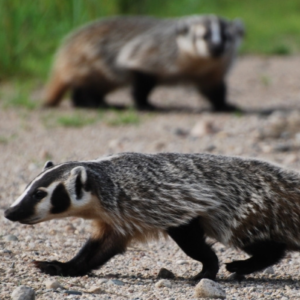
Blackfooted Ferret Nature Canada
The Black-footed Ferret is the only ferret species indigenous to North America. Currently, reintroduction programs are geared towards re-establishing the population. Save endangered species today by joining one of our campaigns! Help End the Extinction
Vital Signs
- Common name: Black-footed Ferret
- Latin name: Mustela nigripes
- Conservation Status: Extirpated
- Range: Alberta, Saskatchewan
- Lifespan: 3 years in the wild, 5-7 years in captivity
- Size: Males average 53 cm in length and 5.8kg, the females are slightly smaller. Their tails alone are 11-15 cm of their entire length!

The Black-footed Ferret has white fur, but the end of each fur strand is dark brown. This makes the ferret look cream coloured, and is perfect for helping it blend in with its habitat. They also have a long body and round, fluffy ears. Its claws are covered by long hairs and there’s fur on the bottom of its feet. The Black-footed Ferret is easily identifiable by a dark brown mask on the face, dark brown feet, and a dark brown tail tip.
Black-footed Ferret Facts
- Diet includes mainly Prairie Dogs but also mice, squirrels and ground nesting birds
- Live in the burrows of Prairie Dogs, where they give birth to and raise their young
- All Black-footed Ferrets alive in North America are descendents of just seven ferrets!
- The Toronto Zoo has raised 269 ferrets since 1992, most of which have been released to the wild
- Those born in captivity attend a “boot camp” to prepare them for life in the wild

Threats
The Black-footed Ferret was believed to be globally extinct. Farmers were killing prairie dogs, the ferret’s main food source, causing ferret populations to drop rapidly. It was only thanks to a hunting dog in Wyoming that a ferret population was found in 1981, revealing that they were not yet extinct.
What’s Being Done
Black-footed Ferret is protected under the federal Species at Risk Act which supports the recovery and conservation of the species. They are also protected under the Saskatchewan Wildlife Act (1998).
The Toronto Zoo has bred Black-footed Ferrets to be released into the wild in Canada, the U.S., and Mexico. To strengthen the effort, the zoo teamed up with Parks Canada, US Fish & Wildlife Service, other organizations, the Calgary Zoo, and some private stakeholders.
Frequent monitoring takes place to track how these populations are doing, and the data has shown there is hope for the continued recovery of the Black-footed Ferret in the wild.

Canada has committed to the goal of protecting 30% of lands, ocean, and freshwater in Canada by 2030. This goal will help protect ecosystems, restore habitats, and fight climate change. All these things are a step in protecting Canada’s at-risk animals—so let’s hold the federal government to their promise.
How to Help
- Stay Informed: Learn about Black-footed Ferret and share your knowledge with others.
- Learn: Stay informed about endangered species by signing up for Nature Canada’s monthly e-newsletter.
- Find out more: Help us end the extinction by taking action for nature today—visit conservation websites like Nature Canada or join one of our campaigns!
RESOURCES
- Hinterland – Black-footed Ferret
- SARA – Species Profile
- Toronto Zoo – Black-footed Ferret Conservation Recovery Program
Want to Help?
Hello nature life wilderness is the world’s envy. It’s our duty to keep our true north strong and green.
Donate

